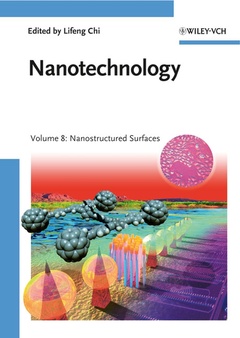Description
Nanotechnology
Volume 8: Nanostructured Surfaces
Nanotechnology Series
Coordinator: Chi Lifeng
Language: English
Subject for Nanotechnology:
Keywords
microscopy; nanostructures; probe; surfaces; strategy; part; fabrication; topdown; tool; surface; advances; nanopatterning; nanoimoprint; nanoimprint; printing; microcontact; lithography; diblock; nanolithography; colloidal; copolymer
Publication date: 08-2010
457 p. · 17.8x24.9 cm · Hardback
457 p. · 17.8x24.9 cm · Hardback
Description
/li>Contents
/li>Biography
/li>
This front line reference investigates nanostructured surfaces, invisible to the naked eye. Machinery and processes explained in a logical fashion. Students and professionals will benefit from the knowledge imparted by the prominent authors.
Part One Top-Down Strategy
1 Top-Down Fabrication of Nanostructures
2 Scanning Probe Microscopy as a Tool for the Fabrication of Structured Surfaces
3 Physical, Chemical, and Biological Surface Patterning by Microcontact Printing
4 Advances in Nanoimprint Lithography: 2-D and 3-D Nanopatterning of Surfaces by Nanoimoprint Lithography, Morphological Characterization, and Photonic Applications
Part Two Bottom-Up Strategy
5 Anodized Aluminum Oxide
6 Colloidal Lithography
7 Diblock Copolymer Micelle Nanolithography Characteristics and Applications
8 The Evolution of Langmuir?Blodgett Patterning
9 Surface-Supported Nanostructures Directed by Atomicand Molecular-Level Templates
10 Surface Microstructures and Nanostructures in Natural Systems
1 Top-Down Fabrication of Nanostructures
2 Scanning Probe Microscopy as a Tool for the Fabrication of Structured Surfaces
3 Physical, Chemical, and Biological Surface Patterning by Microcontact Printing
4 Advances in Nanoimprint Lithography: 2-D and 3-D Nanopatterning of Surfaces by Nanoimoprint Lithography, Morphological Characterization, and Photonic Applications
Part Two Bottom-Up Strategy
5 Anodized Aluminum Oxide
6 Colloidal Lithography
7 Diblock Copolymer Micelle Nanolithography Characteristics and Applications
8 The Evolution of Langmuir?Blodgett Patterning
9 Surface-Supported Nanostructures Directed by Atomicand Molecular-Level Templates
10 Surface Microstructures and Nanostructures in Natural Systems
Lifeng Chi studied physics and physical chemistry at Jilin University, China, and received her PhD in 1989 in Göttingen, Germany, working on electron/energy transfer in thin organic films. After a postdoctoral stay at the University of Mainz and BASF, she moved to the University of Münster in 1993 where she received a Lise Meitner scholarship to obtain her lecturing qualification while working on nanostructuring through self-organization in organic films. She became a professor of physics at the University of Münster in 2004. She has co-authored more than 180 original papers, filed ten patent applications, holds one adjunct and two guest professorships in China and sits on one editorial board. Professor Chi's research interests include surface patterning by bottom-up strategies through self-organization, STM/AFM investigation of soft molecular assemblies, the connection between micro- and nanostructures, and surface functionalization through self-assembly.
© 2024 LAVOISIER S.A.S.




